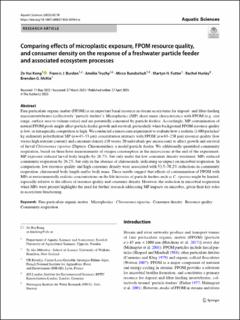| dc.contributor.author | Kong, Ze Hui | |
| dc.contributor.author | Burdon, Francis J. | |
| dc.contributor.author | Truchy, Amélie | |
| dc.contributor.author | Bundschuh, Mirco | |
| dc.contributor.author | Futter, Martyn N. | |
| dc.contributor.author | Hurley, Rachel | |
| dc.contributor.author | McKie, Brendan G. | |
| dc.date.accessioned | 2023-09-21T14:00:36Z | |
| dc.date.available | 2023-09-21T14:00:36Z | |
| dc.date.created | 2023-05-15T12:03:42Z | |
| dc.date.issued | 2023 | |
| dc.identifier.citation | Aquatic Sciences. 2023, 85 (3), 70. | en_US |
| dc.identifier.issn | 1015-1621 | |
| dc.identifier.uri | https://hdl.handle.net/11250/3091136 | |
| dc.description.abstract | Fine particulate organic matter (FPOM) is an important basal resource in stream ecosystems for deposit- and filter-feeding macroinvertebrates (collectively ‘particle feeders’). Microplastics (MP) share many characteristics with FPOM (e.g. size range, surface area to volume ratios) and are potentially consumed by particle feeders. Accordingly, MP contamination of natural FPOM pools might affect particle feeder growth and survival, particularly when background FPOM resource quality is low, or intraspecific competition is high. We conducted a microcosm experiment to evaluate how a realistic (1400 particles/kg sediment) polyethylene MP (ø = 45–53 µm) concentration interacts with FPOM (ø = 63–250 µm) resource quality (low versus high nutrient content) and consumer density (10 versus 20 individuals per microcosm) to affect growth and survival of larval Chironomus riparius (Diptera: Chironomidae), a model particle feeder. We additionally quantified community respiration, based on three hour measurements of oxygen consumption in the microcosms at the end of the experiment. MP exposure reduced larval body lengths by 26.7%, but only under the low consumer density treatment. MPs reduced community respiration by 26.2%, but only in the absence of chironomids, indicating an impact on microbial respiration. In comparison, low resource quality and high consumer density were associated with 53.5–70.2% reductions in community respiration, chironomid body length and/or body mass. These results suggest that effects of contamination of FPOM with MPs at environmentally realistic concentrations on the life histories of particle feeders such as C. riparius might be limited, especially relative to the effects of resource quality and consumer density. However, the reduction in microbial respiration when MPs were present highlights the need for further research addressing MP impacts on microbes, given their key roles in ecosystem functioning. | en_US |
| dc.language.iso | eng | en_US |
| dc.publisher | Springer | en_US |
| dc.rights | Navngivelse 4.0 Internasjonal | * |
| dc.rights.uri | http://creativecommons.org/licenses/by/4.0/deed.no | * |
| dc.title | Comparing effects of microplastic exposure, FPOM resource quality, and consumer density on the response of a freshwater particle feeder and associated ecosystem processes | en_US |
| dc.type | Peer reviewed | en_US |
| dc.type | Journal article | en_US |
| dc.description.version | publishedVersion | en_US |
| dc.rights.holder | © 2023 The Authors | en_US |
| dc.source.pagenumber | 11 | en_US |
| dc.source.volume | 85 | en_US |
| dc.source.journal | Aquatic Sciences | en_US |
| dc.source.issue | 3 | en_US |
| dc.identifier.doi | 10.1007/s00027-023-00964-w | |
| dc.identifier.cristin | 2147527 | |
| dc.source.articlenumber | 70 | en_US |
| cristin.ispublished | true | |
| cristin.fulltext | original | |
| cristin.qualitycode | 1 | |

